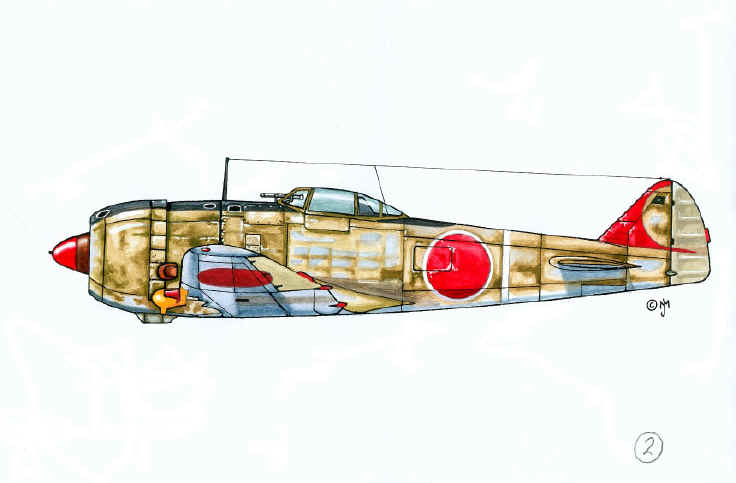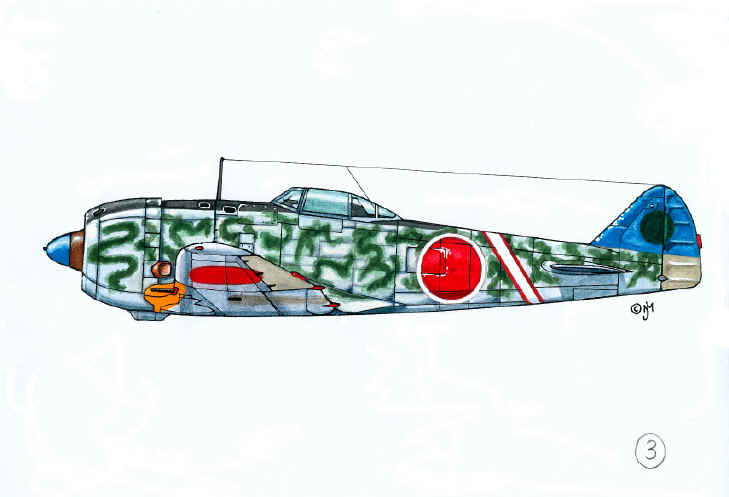- Tojos Over Burma
- by Nick Millman
-
- Colour Profile Notes
- The usual disclaimer. The profiles are
intended to illustrate camouflage and markings only and are not scale
technical illustrations. They represent a personal interpretation and
are not intended to be definitive or to discredit other
interpretations. I have provided sources and identified where details
are speculative.

1. Ki44 I First production series,
"113", 47th Independant Chutai, Mudon, Burma, February 1942
- This is the very first aircraft of the
production series of forty Ki-44 I’s, serial numbers 113-152, manufactured
between February and October 1942 and was one of the replacement aircraft
issued to the 47th FCS in Burma. The upper surface colour is recalled
as a deep green and appears to be softly sprayed giving a blotchy
appearance. Undersurface colour is unknown but appears to be painted
rather than natural metal. It is depicted here as a pale grey-green,
the overall factory finish of the pre-production versions. The
aircraft is numbered with the last two digits of the serial painted in
yellow across the fin. The serial number is stencilled on a
small patch of the grey-green base colour and shows against the white
fuselage band. The band is reported to have been a shotai (flight) command
marking. It is not known if the unit insignia, the “Yamaga”
style camp-drum, was painted beneath the cockpit on the port side as on
earlier aircraft. The aircraft appears to have fuselage hinomaru with
a very thin pale outline, perhaps created when the airframe was camouflaged,
but the evidence is not conclusive.
- Source: FAOW 16, pages 21-22

2. Ki44 II Otsu, 87th Sentai, 2nd Chutai,
Meiktila, Burma, May 1944
- A reconstruction using contemporary newsreel
footage, the faded and worn finish on this particular Shoki gives the
appearance of a sparse mottle over the natural metal. Other aircraft
in the unit are plain natural metal or have the mop-applied “scribble” so
typical of the type. At least one aircraft appears to have the
fuselage hinomaru outlined in yellow - a variation occasionally
reported by RAF pilots in Burma. The camouflage is depicted here as
“green-brown”. The white fuselage stripe does not appear to be a
senchi hiyoshiki, the so-called “combat band”, as other aircraft can be
seen with stripes of similar width and position but in different colours -
perhaps it was a command or sub-unit marking. The spinner and wing-cannon
fairings are painted in the Chutai colour, a known practice in this
unit -although the 40mm weapons do not appear to be fitted. Note
the actual style of the “Spirit of the Wind” tail marking - the 87th
insignia has been shown incorrectly in many publications including recent
“definitive” guides. 1st Chutai used blue and 3rd yellow.
- Source: Contemporary Japanese newsreel film

-
- 3. Ki44 II Hei, “1468”, Unknown Unit, Thedaw,
Burma, Feb-March 1945
-
- This is one of the aircraft described and
sketched by Flt Lt C D Horsman in his report dated 31 March 1945. It
is depicted in a “typical” mottle of deep green over natural metal.
The blue painted spinner is speculative. It is probable that Horsman
misinterpreted the 87th Sentai tail marking on airframes with damaged or
missing rudders (in which case this a 1st Chutai aircraft) but it is
just possible that these markings represent a previously unidentified ad-hoc
unit. The diagonal fuselage bands are in a style that was also seen on
87th Sentai Ki-27 Nates. Other Ki-44 aircraft sketched and described
by Horsman were “1497” with a green disk on a brownish-yellow tail and two
diagonal red fuselage bands outlined in white and “1526” with a green disk
on a red tail and a single vertical white fuselage band (similar to a
standard senchi hiyoshiki). Both these aircraft had a green mottle
over natural metal finish. All the aircraft are described as having
plain red hinomaru on both surfaces of the wings and fuselage hinomaru with
white outlines.
- Source: PRO File AIR 24/1312
-
-
- 4. Ki44 II Hei, 50th Sentai, 1st Chutai,
Meiktila, 1944
-
- This splendid looking Shoki is reconstructed
from the only known photograph of a Ki-44 in 50th Sentai markings. The
upper surface camouflage appears to be well defined and hard-edged blotches
of deep green over the very heavily oxidised natural metal, giving a
striking effect. The Sentai lightning flash is depicted speculatively
here as red for the 1st Chutai but may have been yellow for the 2nd Chutai
or indeed some other colour representing a supernumerary formation. 3rd
Chutai used white. The 50th usually painted individual aircraft
“names”, in Kanji, on the rudders of their Ki-43 aircraft but it is not
known if the Shokis were also marked in this way. Spinner and propeller
blades are dark brown, with control surfaces painted grey-green.
- Source: FAOW 16, page 65
Return
to Profile Menu




